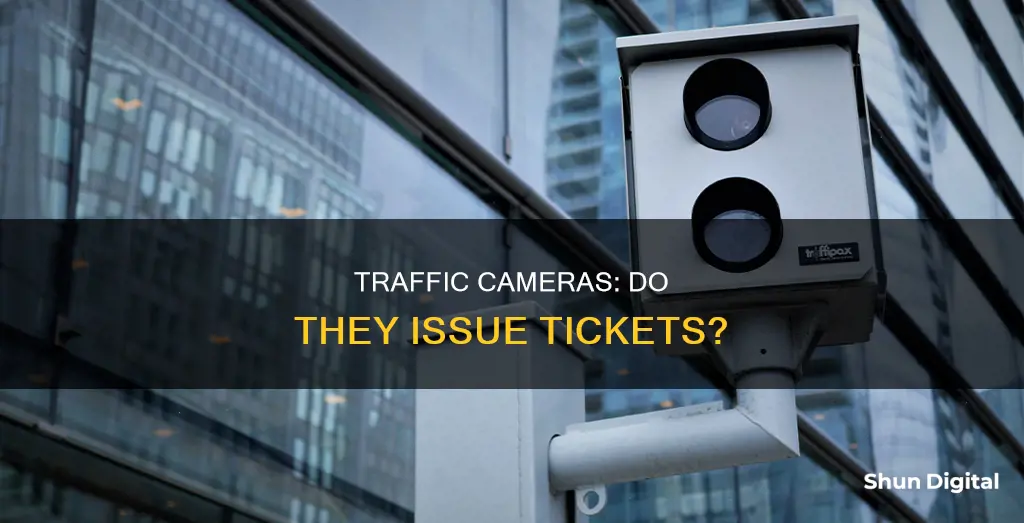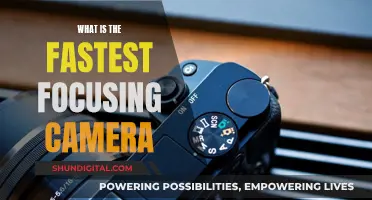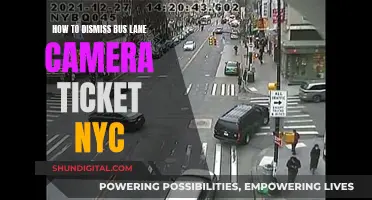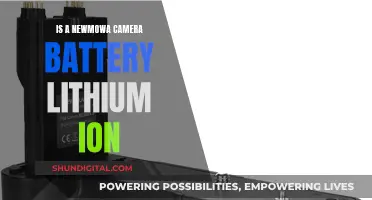
Traffic cameras are an increasingly common feature of roads and intersections, and they serve a variety of purposes, from monitoring traffic flow to enforcing road safety. While some traffic cameras are purely observational, others are equipped with technology to detect violations and issue tickets. Red light cameras, for example, are placed at busy intersections and can detect when a driver enters on a red light, resulting in a ticket being mailed to the motorist. Speed cameras, on the other hand, are often placed on less crowded roads and residential areas, and they automatically detect and issue speeding violations. These automated traffic enforcement cameras are distinct from traffic sensor cameras, which are typically smaller and used to measure traffic flow and adjust traffic light timing. While some question the legality and effectiveness of these cameras, they are becoming an integral part of road safety and enforcement.
| Characteristics | Values |
|---|---|
| Purpose | To make intersections safer by deterring violations |
| Data Collected | Videos, pictures |
| Ticket Issuing | Depends on the type of camera |
| Ticket Type | Administrative violations, like parking tickets |
| Ticket Delivery | Mailed to the driver or vehicle owner |
| Ticket Payment | Online, mail, email, fax |
| Ticket Contest | Possible on procedural grounds |
What You'll Learn
- Red light cameras detect vehicles entering an intersection on a red light
- Speed cameras detect vehicles exceeding the speed limit
- Traffic cameras monitor general traffic conditions
- Automated Number Plate Recognition (ANPR) cameras track driver whereabouts
- Cameras monitor school zones, bus lanes, and traffic-control signs

Red light cameras detect vehicles entering an intersection on a red light
Traffic surveillance cameras themselves do not issue tickets, but they are monitored by law enforcement to monitor intersections and enforce traffic light laws. Red light cameras, on the other hand, are specifically designed to detect vehicles entering an intersection on a red light and issue tickets to the driver.
Red light cameras are automated enforcement systems that use sensors installed in the road to detect vehicles entering an intersection during a red light. The sensors trigger the camera to take multiple pictures of the offending vehicle, providing evidence for authorities to prosecute light-runners. These cameras are typically positioned at the corners of an intersection, mounted on poles a few yards high, to capture images from different angles.
The Insurance Institute for Highway Safety reports that 22% of all traffic accidents in the United States are caused by drivers running red lights, resulting in approximately 800 fatalities and $7 billion in damages annually. To address this issue, many cities have implemented red-light camera systems to improve road safety.
When a red light camera detects a violation, the vehicle's owner or driver will typically receive a ticket in the mail a few weeks later. This ticket includes photographs of the violation, along with instructions for paying the associated fine or contesting the charge. It's important to note that red light camera tickets are treated as administrative violations, similar to parking tickets, and do not result in criminal charges or moving violations.
While red light cameras are effective in reducing accidents and enforcing traffic laws, they are not without controversy. Some people consider them an invasion of privacy, and there are concerns about their accuracy and potential misuse. Additionally, the use of red light cameras varies by state and locality, with some states banning their use altogether.
Surveillance Cameras: A Show's Unique Focus
You may want to see also

Speed cameras detect vehicles exceeding the speed limit
Traffic surveillance cameras are not all the same and serve different purposes. While some are there just to monitor traffic, others are there to detect violations and issue penalties.
Speed cameras are a type of traffic surveillance camera that detect vehicles exceeding the speed limit. These cameras are usually placed in high-risk locations such as tunnels or areas with a history of severe crashes. They can be fixed or mobile. Fixed speed cameras are placed on poles above roadways and are easily identifiable, while mobile speed cameras are moved from location to location in a vehicle, making them harder to spot.
Speed cameras use different methods to detect speeding vehicles. Fixed digital speed cameras use electronic sensors embedded in the road surface to accurately measure the speed of a vehicle. If a vehicle is detected speeding, a digital image is recorded, including the vehicle type, number plate, location details, direction of travel, speed, speed limit, and lane. Mobile speed cameras, on the other hand, use multiple cameras in different locations to calculate the average speed of a vehicle over a certain distance. These "entry and exit cameras" use Automatic Number Plate Recognition (ANPR) to record the vehicle's registration plate and match the data recorded from both cameras.
The use of speed cameras has been shown to effectively deter speeding and reduce crashes, thereby improving road safety and preventing injuries and deaths.
Surveillance Cameras: Effective Security or Privacy Invasion?
You may want to see also

Traffic cameras monitor general traffic conditions
Traffic cameras are video cameras that monitor general traffic conditions. They are also called traffic sensor cameras or traffic monitoring cameras. They are placed on major roads like highways, freeways, expressways, and arterial roads. They are usually connected to each other by optical fibres that are buried next to or under the road.
Traffic monitoring cameras are typically deployed at strategic locations along roads and highways to provide a comprehensive view of traffic flow and conditions. These cameras may be mounted on poles, bridges, or other structures and are usually placed at intersections, on-ramps, and other points where traffic is likely to be heavy or congested.
Once deployed, the cameras are connected to a control centre or network, where the images they capture can be viewed in real time by traffic engineers or law enforcement personnel. These individuals can use the images from the traffic monitoring cameras to monitor traffic flow, detect accidents or other disruptions, and take appropriate action if necessary.
Traffic cameras are not the same as road safety cameras, which are set up in specific places to ensure people follow the rules of the road by taking still photos at a much higher resolution when triggered.
While traffic cameras can be remotely controlled to focus on an accident, the footage is often not kept or used to determine the cause of an accident. They are mostly monitoring systems to measure travel times or study traffic.
Outdoor Camera Blurry: Why and How to Fix It
You may want to see also

Automated Number Plate Recognition (ANPR) cameras track driver whereabouts
Traffic cameras are distinct from road safety cameras, which are installed in specific locations to ensure that people follow the rules of the road by taking high-resolution still photos when triggered. In contrast, traffic cameras, also known as traffic sensor cameras or traffic monitoring cameras, are video cameras that monitor general traffic conditions on major roads like highways, freeways, expressways, and arterial roads. They are typically connected through optical fibres buried alongside or beneath the road and can be powered by mains electricity, solar panels, or alternative sources that avoid power outages.
Traffic cameras do not issue tickets or enforce road rules; instead, they are used for monitoring and studying traffic flow and travel times. Automated Number Plate Recognition (ANPR) Cameras are a type of traffic camera that is primarily used to track the whereabouts of drivers.
ANPR is a technology that uses optical character recognition (OCR) and image or video analytics to read and capture license plate information from vehicles. It can use existing closed-circuit television, road-rule enforcement cameras, or specialised cameras. ANPR cameras are designed to capture high-quality images of license plates, with features such as high-resolution imaging, infrared illuminators, wide dynamic range, fast shutter speed, and specialised lenses.
ANPR systems are commonly used by police forces worldwide for law enforcement, including checking vehicle registration and licenses, as well as tracking criminal activities. They are also employed for electronic toll collection, border control, traffic management, and parking management. ANPR assists in traffic monitoring by tracking average speeds, identifying traffic violations, and enforcing tolls or congestion charges.
While ANPR provides benefits in terms of improved efficiency, accurate identification, and process automation, it also raises privacy concerns due to the potential for mass surveillance and the storage of vehicle movement data.
The Multiplane Camera: Revolutionizing Animation's Depth and Dimension
You may want to see also

Cameras monitor school zones, bus lanes, and traffic-control signs
Cameras are increasingly being used to monitor school zones, bus lanes, and traffic-control signs. In New York City, for example, speed cameras operate in 750 school speed zones, issuing tickets to vehicle owners if their car is observed travelling more than 10 mph over the speed limit. Similarly, Queensland, Australia, is piloting a road safety program using portable hi-tech speed cameras attached to powered road signs in school zones and roadworks to deter motorists from speeding. The presence of these cameras is intended to reduce the number of speeding drivers, which accounted for over 30% of road deaths in Queensland in 2023.
In addition to monitoring speed, cameras can also be used to enforce other traffic rules, such as stopping at school bus stop arms. The Safe Fleet Stop Arm Violation Enforcement System (SAVES) uses AI technology and advanced algorithms to monitor and record violations, providing law enforcement with comprehensive evidence to enforce school bus passing laws. This system has been shown to increase driver awareness of posted laws and improve student safety.
Bus lanes can also be monitored by cameras to enforce lane discipline. For example, the Automated Bus Lane Enforcement (ABLE) system is designed to detect and deter violations, improving passenger and pedestrian safety.
Overall, the use of cameras to monitor school zones, bus lanes, and traffic-control signs is an important tool for improving road safety, particularly around vulnerable road users such as school children and road workers. By deterring speeding and other traffic violations, these camera systems can help reduce the number of accidents and save lives.
Traffic Camera Tickets: Are They Legit?
You may want to see also
Frequently asked questions
Traffic surveillance cameras themselves do not issue tickets. However, there are other types of cameras that do, such as red light cameras and speed cameras.
Red light cameras are placed at busy intersections to detect when a driver enters during a red light. If this is detected, the camera will take multiple images of the car and the driver will receive a ticket in the mail.
Red light cameras are always located near busy intersections and they tend to be bulkier than other cameras, with a large camera box and two external flashes mounted on separate poles. There are usually multiple cameras at each intersection to capture different angles.
Speed cameras are similar to red light cameras but are used to detect speeding violations instead of red-light violations.
Speed cameras are typically placed on less crowded back roads and in residential areas where speeding has been an issue.
If you receive a traffic camera ticket, you should contact a lawyer as soon as possible to review your options. In some cases, you may be able to contest the ticket if you can prove that someone else was driving your car or if there are procedural grounds for a challenge.







